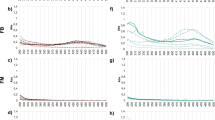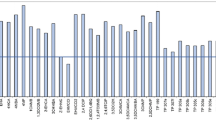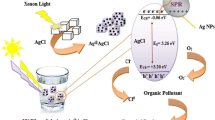Abstract
The study on the photostability of six UV filters in aqueous solution was combined with investigations on the phytotoxicity of the produced degradation mixtures. During the exposure to artificial sunlight over 72 h, the degradation of three of the UV filters evaluated was observed with half-lives between 20 and 59 h. The structural changes of iso-amylmethoxy-cinnamate (IAMC), ethylhexyl-methoxy-cinnamate (EHMC), and 4-methylbenzyliden camphor (4-MBC) occurred during irradiation were consistent with isomerisation and polymerization (IAMC and EHMC) whereas 2-ethylhexyl-4-(dimethylamino)benzoate (OD-PABA) was degraded. The analysis of the UV filters and their degradation products was performed by stir bar sorptive extraction (SBSE) followed by thermodesorption–gas chromatography–mass spectrometry (TD-GC-MS) or liquid desorption–liquid chromatography–mass spectrometry (LD-LC-MS). The phytotoxicological potential of the UV filters was examined in vitro by evaluating reproduction inhibition of the chlorophyte microalgae Scenedesmus vacuolatus. Excess toxicity was calculated by comparing experimental derived median efficiencies after log-logistic modeling to predict effects assuming narcotic mode of action. Benzophenone-3 (BP-3) showed 43-fold higher toxicity than theoretically predicted and a more specific mode of action was assumed. The other UV filters tested indicated toxicity in the range of modeled narcosis. For IAMC, EHMC, and OD-PABA the phytotoxicity of their photodegradation mixtures was followed over time. Phytotoxicity decreased directly with the reduction of the parent substance from the solution. Five of the tested UV filters do not represent a risk at least for algae. Octocrylen and 4-MBC were found to be photostable but few toxic to algae. EHMC, IAMC, and OD-PABA were fast degraded during UV radiation and the phytotoxicity of the corresponding degradation mixtures was low and decreased onward during exposure. Thus, for the UV filters studied, it could be confirmed that sunlight can account noticeably for decontamination and detoxification of contaminated water. However, due to its potential accumulation in combination with a specific mode of action, BP-3 may imply probable environmental risks at least to algae. This study emphasizes the need of a combined chemical and toxicological evaluation for a reliable risk assessment concerning degradation processes exemplified here for UV-protecting agents.







Similar content being viewed by others
Explore related subjects
Discover the latest articles and news from researchers in related subjects, suggested using machine learning.References
FDA, Department of Health and Human Services, 21CFR Parts 310, 352, 700 and 740, RIN 0910-AA01, Sunscreen Drug Products for over-the-counter Human Use Final Monograph, Federal Register, Rules and Regulations, 64 (1999) 27666
Council Directive 76/768/EEC of 27 July 1976 on the approximation of the laws of the Member States relating to cosmetic products and its successive amendments, basic act 31976 L0768. Off J Eur Commun L 262 (27.9.1976):169, http://eur-lex.europa.eu/LexUriServ/LexUriServ.do?uri=CELEX:31976L0768:EN:HTML
Giokas DL, Salvador A, Chisvert A (2007) Trends Anal Chem 26:360–374
Rodil R, Moeder M (2008) J Chromatogr A 1179:81–88
Balmer ME, Buser HR, Müller MD, Poiger T (2004) Agroscope. Swiss Federal Research Station for Horticulture, Plant Protection Chemistry, Wädenswil, Switzerland
Poiger T, Buser HR, Balmer ME, Bergqvist PA, Müller MD (2004) Chemosphere 55:951–963
Kupper T, Plagellat C, Brändli RC, de Alencastro LF, Grandjean D, Tarradellas J (2006) Water Res 40:2603–2612
Balmer M, Buser HR, Müller MD, Poiger T (2005) Environ Sci Technol 39:953–962
Nagtegaal M, Ternes TA, Baumann W, Nagel R (1997) Umweltchem Okotox 9:79–86
Buser HR, Balmer M, Schmid P, Kohler M (2006) Environ Sci Technol 40:1427–1431
Hany J, Nagel R (1995) Deutsche Lebensmittel-Rundschau 91:341–345
Soeborg T, Ganderup NC, Kristensen JH, Bjerregaard P, Pedersen KL, Bollen P, Hansen SH, Halling-Sorensen B (2006) J Chromatogr B 834:117–121
Vidal MT, Chisvert A, Salvador A (2003) Talanta 59:591–599
Schlumpf M, Cotton B, Conscience M, Haller V, Steinmann B, Lichtensteiger W (2001) Environ Health Perspect 109:239–244
Schlumpf M, Schmid P, Durrer S, Conscience M, Maerkel K, Henseler M, Gruetter M, Herzog I, Reolon S, Ceccatelli R, Faass O, Stutz E, Jarry H, Wuttke W, Lichtensteiger W (2004) Toxicology 205:113–122
Cantrell A, McGarvey DJ, Truscott TG (2001) Comprehensive Series in Photosciences 3:495–519
Inbaraj JJ, Bilski P, Chignell CF (2002) Photochem Photobiol 75:107–116
Sakkas VA, Giokas DL, Lambropoulou DA, Albanis TA (2003) J Chromatogr A 1016:211–222
Giokas DL, Vlessidis AG (2007) Talanta 71:288–295
Altenburger R, Walter H, Grote M (2004) Environ Sci Technol 38:6353–6362
Adler NE, Schmitt-Jansen M, Altenburger R (2007) Environ Toxicol Chem 26:297–306
Schmitt-Jansen M, Bartels P, Adler N, Altenburger R (2007) Anal Bioanal Chem 387:1389–1396
Franz S, Altenburger R, Heilmeier H, Schmitt-Jansen M (2008) Aquat Toxicol 90:102–108
Altenburger R, Boedeker W, Faust M, Grimme LH (1990) Ecotoxicol Environ Saf 20:98–114
Ricci A, Chrétien MN, Maretti L, Scaiano JC (2003) Photochem Photobiol Sci 2:487–492
Broadbent JK, Martincigh BS, Raynor MW, Salter LF, Moulder R, Sjöberg P, Markides KE (1996) J Chromatogr A 732:101–110
Bertoniere N, Franklin WE, Rowland SP (1971) J Appl Polymer Sci 15:1743–1751
Technical Guidance Document in Support of Commission Directive 93/67/EEC on Risk Assessment for New Notified Subtances and Commission Regulation (EC) No 1488/94 on Risk Assessment for Existing Substances, Part II. (http://ecb.jrc.ec.europa.eu/Documents/TECHNICAL_GUIDANCE_DOCUMENT/EDITION_2/tgdpart2_2ed.pdf)
Lambropoulou DA, Giokas DL, Sakkas VA, Albanis TA, Karayannis MI (2002) J Chromatogr A 967:243–253
US EPA (2009). Estimation programs interface suite™ for Microsoft ® Windows, v 4.00. Environmental Protection Agency, Washington, DC, USA. (http://www.epa.gov/oppt/exposure/pubs/episuite.htm)
Acknowledgments
R.R. acknowledges Ministerio de Educación y Ciencia for her contract sponsorship through the Ramon y Cajal research program. This work was financially supported partially by Ministerio de Educación y Ciencia and E.U. FEDER funds (Project no. “CTQ2007-63949/BQU“).We are indebted to Prof. A. Salvador (University of Valencia) for the kind gift of some pure standards. The Helmholtz Center for Environmental Research UFZ indicates support by the EU Projects MODELKEY (EC 6th Framework Program Contract No 511237 (GOCE)) and (KEYBIOEFFECTS, MRTN-CT-2006-035695).
Author information
Authors and Affiliations
Corresponding author
Rights and permissions
About this article
Cite this article
Rodil, R., Moeder, M., Altenburger, R. et al. Photostability and phytotoxicity of selected sunscreen agents and their degradation mixtures in water. Anal Bioanal Chem 395, 1513–1524 (2009). https://doi.org/10.1007/s00216-009-3113-1
Received:
Revised:
Accepted:
Published:
Issue Date:
DOI: https://doi.org/10.1007/s00216-009-3113-1




